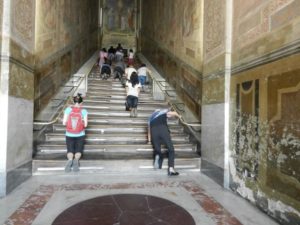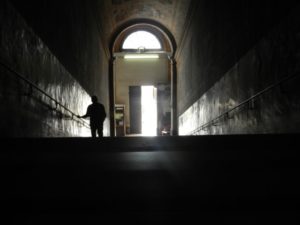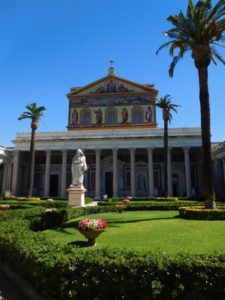Major Basilicas are the last step before the Pearly Gates. They are often destinations of pilgrims. The ones in Rome, Italy – there are four – are at the top of the incline because they house the bones, relics, remnants of our most important Biblical heroes and saints. In Rome, already the capital of Catholicism no matter how you look at it, the royalty of the basilicas is St. Peter’s where the Pope resides, gives mass, and greets the penitent and the diplomat. It is the largest church in Christendom. Why? Because the apostle to whom Jesus gave the keys to the kingdom is buried under the high altar, and that is really something special. It can not be called a cathedral because it’s the Pope’s home, not the bishop’s. My first visit to St. Peters was when I was 18 years old on “The Tour” proper young girls needed in those days (sailing over on the Cristoforo Colombo and Ile de France on the return). We had an audience with Pope Pius XII, who blessed us and our medals. This was 1958. He died that same year. St. Peter’s also has historical relativity to our early Christian Church and the Protestant Reformation.
When one enters a basilica, no matter what it’s shape or form, – but always there is the dome – it’s impossible not to be exuberant with awe and amazed at how huge things are from the inside as well as the outside. St. Peter’s is entered after crossing a square about the size of Overton Park. The sun beats down as you focus on the columns and statues in the half circle on either side where one might see a young Swiss guard dressed in yellow, blue, red and with a large black plume in his hat. They are above all polite and helpful and they protect the Pope. But walk through the gigantic door – or the Holy Door if allowed – puts us on another planet, it seems, where the great artworks from frescos to mosaics of the Renaissance are visible. Credit for the interior goes to Bramante, Michelangelo, Maderno and Bernini. Who can pass by Michelangelo’s Pieta without feeling the pain of a mother embracing her dead son? There have been so many threats against some of the great works that now it is protected by guards, glass and all sorts of precautions, so it is difficult to get close like we could in previous days. I spent a lot of time here in 1982-3 studying for a Master’s degree in Art History. Having access was a privilege I never appreciated until now, where everyone has to be held at a long arm’s length. But the emotion still surrounds this work.
 In the middle of St. Peters is the high altar designed by Bernini – It is called a baldacchino or canopy and is the largest piece of bronze in the world, so they say, which stands beneath the dome and above the altar, creating a holy space above and around the table on which the Sacrament is laid for Eucharist because the Sacrament becomes the body and blood of Christ. It also hovers over the underground residency of the bones of St. Peter. The four columns of brown bronze holding up the canopy and decorated with laurel leaves and bees, were modeled by those in the Temple of Jerusalem and donated by Emperor Constantine. But deep beneath this ornate altar are two others, one on top of the other, and finally the treasured bones of St. Peter. The creme de la creme is to be among the few mortals selected to take the two hour tour underground, to learn the history of the discovery of the bones, and, alas, to actually see one bone of St. Peter from about 16 feet away in a small slither of space. For anyone in the Catholic faith (and I would add be he or she Roman, Anglican or Orthodox) this is a major spiritual moment. It is called the Vatican Scavi.
In the middle of St. Peters is the high altar designed by Bernini – It is called a baldacchino or canopy and is the largest piece of bronze in the world, so they say, which stands beneath the dome and above the altar, creating a holy space above and around the table on which the Sacrament is laid for Eucharist because the Sacrament becomes the body and blood of Christ. It also hovers over the underground residency of the bones of St. Peter. The four columns of brown bronze holding up the canopy and decorated with laurel leaves and bees, were modeled by those in the Temple of Jerusalem and donated by Emperor Constantine. But deep beneath this ornate altar are two others, one on top of the other, and finally the treasured bones of St. Peter. The creme de la creme is to be among the few mortals selected to take the two hour tour underground, to learn the history of the discovery of the bones, and, alas, to actually see one bone of St. Peter from about 16 feet away in a small slither of space. For anyone in the Catholic faith (and I would add be he or she Roman, Anglican or Orthodox) this is a major spiritual moment. It is called the Vatican Scavi.
Our ticket story was like a lot of ticket stories – we had two reserved for 8:30 a.m. then the time was changed because a mass was beginning in the square to make up for the fact on Sunday the normal mass would be substituted by the world wide canonization of Mother Teresa, which would draw over 100,000 down lanes, paths, streets and sidewalks to fill the square where the Pope celebrates the misa weekly. I was devastated as this had been high on the list. But my super guide Eva convinced the Vatican ticket distributer to allow us to squeeze in at noon, so we were delighted, although cautious that it might change again, as those things happen often around the Vatican. When we returned, we and another couple were the only ones there. So we were in. Then, almost too late, came an elderly group of ten out of breath but eager.
 We began in a narrow long hall where immediately the impact of being under ground and in a cavern was causing me to sweat and wonder if I really wanted this experience. I’m not good at closed spaces and couldn’t help but think that only a couple of weeks prior there had been a destructive earthquake 100 miles away that destroyed many things and the last place I’d want to be was stuck underground with no air. But, I gathered up my gusto and edged and wedged into the corners and areas we had to step upon to see this or that important place. It got hotter and hotter and the stone pathway and steps, more and more points of fear. Surviving the tour meant I would see a real live bone of St. Peter. And this can be a holy thing. Peter’s ministry had taken him to Rome and there he was martyred along with St. Paul on Oct. 13, AD 64 during the days of Roman Emperor Nero, the one who fiddled while Rome burned. Peter was crucified upside down because he didn’t consider himself equal or worthy to die as did Christ. In the middle of St. Peter’s Square (beside which I sat the entire Mass for Mother Teresa’s canonization) is an ancient Egyptian obelisk where Peter’s crucifixion took place.
We began in a narrow long hall where immediately the impact of being under ground and in a cavern was causing me to sweat and wonder if I really wanted this experience. I’m not good at closed spaces and couldn’t help but think that only a couple of weeks prior there had been a destructive earthquake 100 miles away that destroyed many things and the last place I’d want to be was stuck underground with no air. But, I gathered up my gusto and edged and wedged into the corners and areas we had to step upon to see this or that important place. It got hotter and hotter and the stone pathway and steps, more and more points of fear. Surviving the tour meant I would see a real live bone of St. Peter. And this can be a holy thing. Peter’s ministry had taken him to Rome and there he was martyred along with St. Paul on Oct. 13, AD 64 during the days of Roman Emperor Nero, the one who fiddled while Rome burned. Peter was crucified upside down because he didn’t consider himself equal or worthy to die as did Christ. In the middle of St. Peter’s Square (beside which I sat the entire Mass for Mother Teresa’s canonization) is an ancient Egyptian obelisk where Peter’s crucifixion took place.
There were many burials in the area below St. Peter’s altar as followers and friends tried to be placed as near to Peter as possible. In 1939 when Pope Pius XII was in power, ten years of archaeological research under the crypt of the basilica began to reveal all sorts of tombs and bones discoveries, but there was one grave with rare vestments that suggested someone of great respect was buried there. There are many twists and turns and rooms and sarcophagus and mausoleums and frescoes, but the apostolic memorial is the most intriguing . We arrived at the Vatican Grottoes, and saw where Constantine had erected his Trophy of Gaius and there is a Graffiti Wall with the name of Peter, while the baldacchino of Bernini is perfectly located over the very tomb of St. Peter and we were told avidly and firmly that according to archaeologists and researchers all the bones of St. Peter are present except his feet. So when you encounter relics that claim to be parts of St. Peter, they are not. What we finally saw through a sliver in the lowest altar wall was really one of his bones. You sort of have to go through the experience to understand it all. And to do the tour, you have to have a lot of luck since only 200 people are allowed in the Skavi per day. And that’s the truth.
The Basilica of Santa Maria Maggiore is a different kind of basilica, almost gentle and feminine, and it holds relics of the Holy Crib, and the ancient icon of the Madonna and Child attributed to Saint Luke the Evangelist, who probably painted it being coached by God. And there was a miraculous snowfall in the middle of summer August 5 in this place, prompting Pope Liberius to build this basilica. The snowfall is celebrated each year with a shower of white flower petals in the nave. The holy door here is emotional – one can hold the bar-relief hand of Holy Mary on one side of it, or the hand of Jesus on the other door.
 The Basilica of St. Paul Outside the Wall, the one with the tall palm tree in the front yard, suffered an enormous fire in 1823 that destroyed so many of the treasures but there still exists Paul’s tomb and the chains from his imprisonment and all around the ceiling are ovals with every single Pope ever, and that’s a lot, with only 6 spaces left to fill. The saying is that when those 6 are done, then the world will come to an end. Cheerful thought. But the place is huge, and if you really want to do Paul things, there is a special chapel in a silent, charming monastery where his head was chopped off. Part of the pathway he had to walk down still exists.
The Basilica of St. Paul Outside the Wall, the one with the tall palm tree in the front yard, suffered an enormous fire in 1823 that destroyed so many of the treasures but there still exists Paul’s tomb and the chains from his imprisonment and all around the ceiling are ovals with every single Pope ever, and that’s a lot, with only 6 spaces left to fill. The saying is that when those 6 are done, then the world will come to an end. Cheerful thought. But the place is huge, and if you really want to do Paul things, there is a special chapel in a silent, charming monastery where his head was chopped off. Part of the pathway he had to walk down still exists.
San John de Latern is so monstrous that it’s easy to get lost in the open interior space. The marble statues of the apostles offer a consternation of fear, hope, and faith that we wonder if we could ever reach. Sort of makes you stand up straight and salute. But just to try your stamina, next door is the site of the Holy Steps, that once led up to the praetorium of Pontius Pilate in Jerusalem, the very ones Jesus had to crawl up on the way to his trial during Holy Week, 28 steps worth, a mixture of hard wood and hard marble. Eagerly I bent down to try to do them on my knees, thinking I was so fit, and the pain was so excruciating just on step one that I felt that was a message – I could never suffer the pain Jesus had suffered when He died for us. So I had an option – an alternative, an indulgence where one climbed the steps at the side, standing, and praying through all the events of Holy Week. It wasn’t the same, but at least I did something to excuse my inability to climb on my knees.
The one thing left was a visit to the Catacomb of Priscilla on the Via Salaria. Here one can see how persons were buried – sort of stuck in chiseled out spaces in the rocks and walls, and who was rich and who was not and how seven bodies could be placed on carved out tombs like shelves on one wall. No, Christians didn’t hide out in the catacombs and hold services there. Only the extremely wealthy built family chapels. These were not escape routes, as they had been used for many years by the Jews as burial sites. This well-kept and fascinating catacomb was most appealing to me because of the image of a woman in a chasuble holding her hands up as if celebrating the Eucharist, although I was corrected that that was a popular pose for greeting people and it was also done in the Jewish faith. This catacomb also contains the oldest known Marion painting from the third century – Mary nursing Jesus on her lap, and there is the famous fresco of Jesus as the shepherd. Seven popes and many martyrs are buried here, as are the relics of St. Philomena. It was, for me, another adventure into the underworld, but this time it was well worn, well lit and air-conditioned. Am I spoiled?

